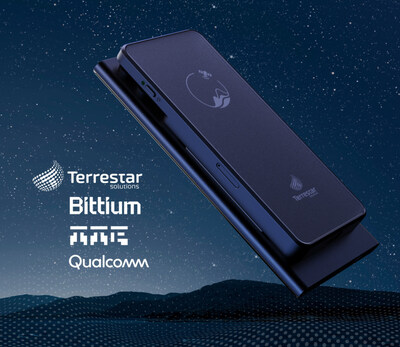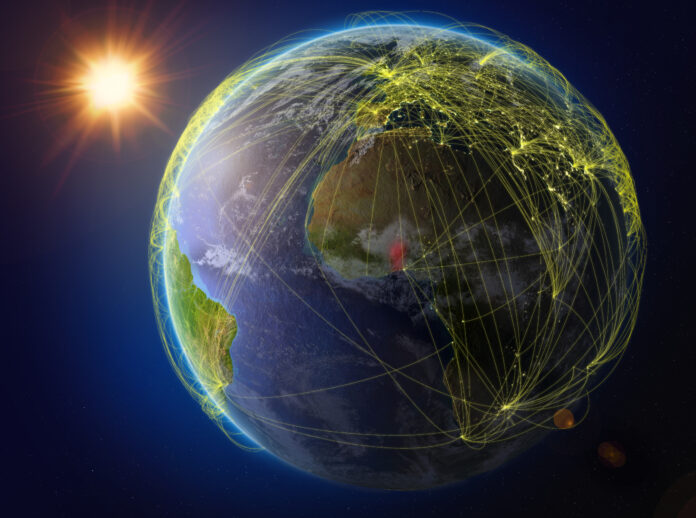Which NB-NTN use case is the ‘juiciest’ for Viasat? The one with the longest sales cycle.
Mobile network operators and satellite operators striking partnerships and beginning to roll out satellite-based cellular services in hopes of capturing new revenues. Last month, Verizon boosted its direct-to-device texting capabilities on some Android phones,
While the many technical challenges of Non-Terrestrial Networks (NTN) are being addressed, there’s a larger question looming: How much of a market is there for these services, and is it a consumer or an enterprise market?
In a recent conversation at the 2025 Satellite Show, Andy Kessler, vice president for Viasat’s enterprise division, discussed the satellite operator’s views on the cellular NTN market with RCR Wireless News.
Viasat has an NB-IoT network that it markets as IoT Direct, which uses the company’s L-band satellite spectrum. In late March, Australian satellite IoT outfit Myriota launched its NB-NTN service, Myriota HyperPulse, using leased capacity from Viasat. Among its other recent deals related to cellular integration, Viasat also signed an MOU with United Arab Emirates-based Space42 last month to explore ecosystem partnerships for developing a 5G NTN in initiative, starting with technical and commercial studies on developing a “shared, or multi-tenant, multi-orbit 5G NTN infrastructure employing a standards-based open architecture” and using L-band, S-band and terrestrial spectrum.
Viasat, Kessler said, is targeting three different NB-NTN use cases. Those are:
Direct-to-consumer. This is the use case getting all the headlines these days: Using satellite-based connectivity with regular smartphones. NB-NTN is the tech underlying the few commercially available standards-based deployments that are out there right now, and more of NB-NTN-capable satellites are expected to be launched this year.
Kessler said that while that market is already developing through devices and carriers, he anticipates that “companion devices” will also be a part of the market.

At this year’s Mobile World Congress Barcelona, Terrestar Solutions, Bittium, TTP and Qualcomm Technologies demonstrated their Sat Companion prototype, which consisted of a slim, snap-on module with a high-gain antenna and Qualcomm 9205S modem inside—not all that dissimilar to the Motorola Z3’s “Moto Mod,” for those who remember the earliest attempts at 5G mmWave devices. The partners promised “seamless connectivity, providing users with uninterrupted SMS, chat, voice, and email services even in the most remote areas” with the Sat Companion device.
Kessler said that Viasat sees a “significant market” for such companion devices and expects there to be acceleration this year. He said that companion devices will enable not only SOS messages but satellite-based SMS more generally, given that Rel. 17 or later capabilities still rare. “So much of the ecosystem is not Release 17-capable. Even with the latest and greatest, it’s really only the flagship phones,” he noted, adding, “The companion device is a nice interim way to get services into the public without people having to sort of make a big leap on a new phone.”
After all, upgrades cycles for smartphones continue to lengthen, but companion devices could enable a wider segment of users to access satellite-based services even without upgrading their smartphone. “We really like the companion devices basically for that dynamic,” he said.
But Kessler doesn’t just see companion devices as a placeholder while waiting for an upgrade cycle to kick in. He anticipates that those type of devices will be a large segment of the direct-to-device consumer market for an extended time period. He also said that for off-grid adventurers, or people who want a back-up for when their phones’ battery dies or a phone is lost, satellite-based companion devices could also be developed that work for standalone, emergency connectivity—but would cost significantly less than the traditional satellite phone, because of the economies of scale that come from a standards-based ecosystem rather than a proprietary one.
“We think that’s a really good feature set to offer folks” so that people have the ability to reach out for help, Kessler said. “We think that’s going to be a big market for us.”
Industrial Internet of Things. “Industrial IoT is actually, I think, the most interesting in terms of how it’s going to change things,” Kessler said.
A survey-based report from Viasat earlier this year found that 85% of businesses said that they had “struggled to develop IoT because of connectivity issues in the areas they want to deploy.”
Fundamentally, he continued, the business case for NTN-based industrial IoT is about reducing barriers to entry. What that really comes down to, Kessler said—and what’s so exciting to the satellite industry and ecosystem right now—is the plummeting cost of compared to a traditional satellite user terminal, and which use cases would open for satellite connectivity as a result.
“We are already seeing strong evidence that we’re going to be able to have ecosystem partners. It truly is an ecosystem, that is going to be able to build and sell the hardware for tens of US dollars,” he said. “That reduction in terms of capital investment and barriers to entry, opens up all these use cases, which you never would have contemplated before.”

He comes back to an example that he jokingly says comes up in every meeting: Cattle tracking. If, say, a cow is worth somewhere between $1,000-$1,500 to a rancher, it doesn’t make sense to put $3,000 into using a satellite-based tracking device on that cow. “But if you can invest $50 to track a $1,500 cow, now all of a sudden that gets really interesting,” Kessler said. Such satellite tracking could, for example, help establish provenance and tracking of cattle so that they can be sold as boutique meats like 100% grass-fed.
How many more things do enterprises (and even consumers) own that cost a few thousand dollars and are therefore worth $50 or so to track? “Asset tracking in remote environments all of a sudden gets really important and really valuable when you can have that,” he said. “So we think of this as opening up all these untapped markets that fundamentally, the economics never made sense before. And now they will.”
Connected car. “Connected car might actually be the juiciest market for us, in terms of the magnitude of it and the opportunities that it presents,” Kessler reflected, adding that connected cars also present the opportunity to integrate a modem with a Rel. 17 or later chipset, as well as provide for a larger antenna that “opens up the possibilities in terms of what services you can deliver.”
Viasat was the first satellite provider to join the 5G Automotive Association, in late 2024. At the time, Kevin Kevin Cohen, VP of direct to device partnerships at Viasat, said: “With a longstanding history in providing critical safety services in the air and at sea, and our continued innovation on direct-to-device connectivity, joining the 5GAA is a natural fit for Viasat. By utilizing already licensed L-band spectrum for mobile satellite services, vehicles could roam between space and ground network connectivity.”
In early March, meanwhile, Viasat announced a first-of-its-kind demonstration of direct-to-device connectivity for the automotive sector, using Viasat’s L-band satellites and satellite NB-NTN provider Skylo’s network, to provide narrowband tracking, monitoring and messaging capabilities, using modules and antennas from Quectel Wireless Solutions that allowed test vehicles to ” seamlessly switch between satellite and cellular networks”. The trials took place over the last four months between Blumenau and Curitiba in southern Brazil, with tests conducted by Viasat partner GuardianSat through Acceleronix.
But the automotive NB-NTN use case has the longest sales cycle of the ones mentioned thus far. Which means, Kessler acknowledged, that it will be faster and easier to achieve noticeable progress on services and customers in the direct-to-consumer use case or in industrial IoT than in the connected car space.
Still, he said that Viasat is “pushing with all urgency on all three fronts.”
NTN: ‘It’s real,’ but the market is still just emerging
What’s the most important thing to understand about the satellite-cellular market right now?
“One of the key things is, it’s real,” Kessler said. “People can now do it. It’s gotten a year further down the maturity path. I have a Release 17-capable phone that I can roam onto satellite now.” More MNOs and MVNOs are recognizing the value of making satellite connectivity a part of their offerings, he added, forming relationships that look a lot like regular, terrestrial roaming arrangements. “There’s a lot of pull in the marketplace right now on that front, which I think gives us enhanced confidence that there really is a market for this,” Kessler said.
He expects the coming year to shed more light on utilization dynamics and how much people are willing to say—which, he acknowledges the ecosystem is “still in the market discovery” phase.
“I think what we will learn in the next year is fundamentally about those two points: about utilization [and] willingness to pay,” Kessler said—but he also reiterated that the market for NTN services is still in its early stages. No one company is likely to serve all the anticipated needs, but there are likely going to have to be strategic adjustments as the market features become clearer.
“This is certainly a period of market discovery right now,” Kessler said. “I would say we would be awfully naive to think that we have the perfectly suited approach in terms of go-to-market right now. So, what we’re fundamentally about is, as we learn, we’re going to recognize where we need to adapt, and it’s likely to change in some way.”

